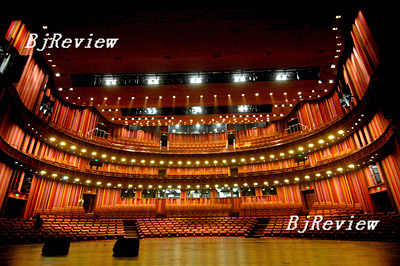
It is one of the newest additions to an ever changing Beijing skyline and has been a talking point for the past six years. Lying in direct design contrast to the more austere Great Hall of the People, the gleaming oval dome of the National Grand Theater, west of the Tiananmen Square, is one of the largest construction projects the city and country has undertaken in recent times.
Covered with a shell of more than 20,000 titanium panels and 1,200 huge laminated sheets of glass, the curved building, occupying a total area of about 149,500 square meters, rises like a gigantic pearl at the center of a 35,500-square-meter artificial lake specifically created to make an almost holographic effect.
The combination of titanium and glass gives the illusion of a tear in the building's middle via a curtain of glass that opens gradually from top to bottom.
The theater's grand opera hall glittered into operation on September 25, the traditional Chinese Mid-Autumn Festival, a special day for family gathering, with a special performance of the Chinese classical ballet The Red Detachment of Women. This performance was part of the preparation and testing phase for the luxurious venue, which enters its first full performance season from this December to March next year, with over 180 scheduled shows. The theater forms a big part of the entertainment options in the capital for foreign audiences during next year's Olympic Games.
The imposing building houses three performance auditoria-a 2,416-seat opera house, a 2,017-seat concert hall and a 1,040-seat theater, as well as art and exhibition spaces open to a wide public.
The test performances running throughout the National Day holiday (October 1-7) are being staged as a special treat to a selected audience, and are not open to the public.
"The audience includes original residents on the site of the theater who have been relocated, builders of the theater and Olympic venues, elite in every walk of life, artists and media reporters," said Deng Yijiang, Vice President of the National Grand Theater.
Performances staged in the testing period include classics featuring Chinese artists, such as ballet Swan Lake, drama Teahouse, Peking Opera-and-symphonic poem Mei Lanfang and Kunqu Opera The Peony Pavilion.
Birth amid dispute
Although the building was listed among the top 10 new landmark buildings in China by the U.S.-based magazine BusinessWeek due to its energy-saving and environment-friendly design, the six-year-long construction has sparked heated debates even since it was conceived in 1998.
The debates were mainly focused on whether the silver futuristic design fits the surrounding environment in the heart of Beijing that features the more formal Chinese-style architecture and bland colors.
| 